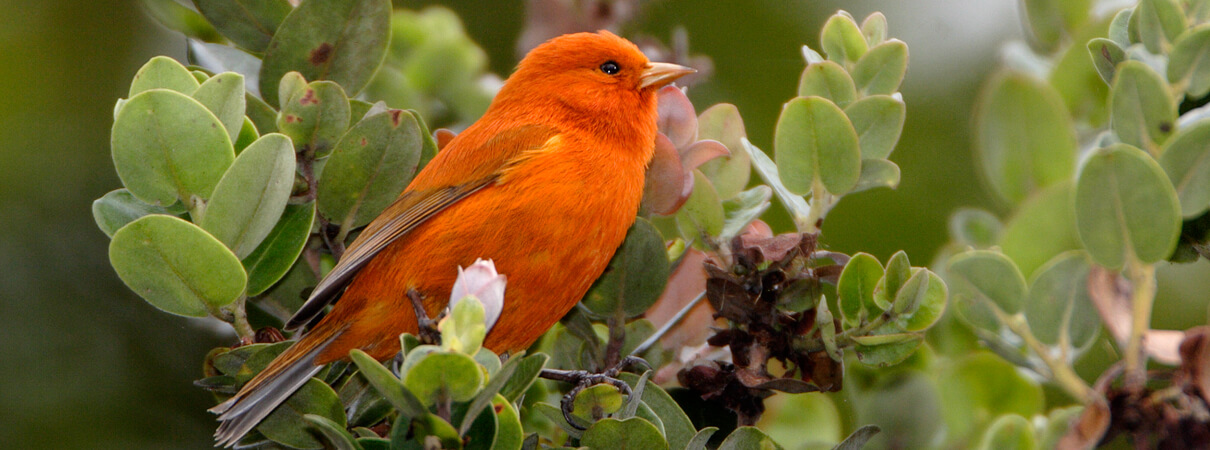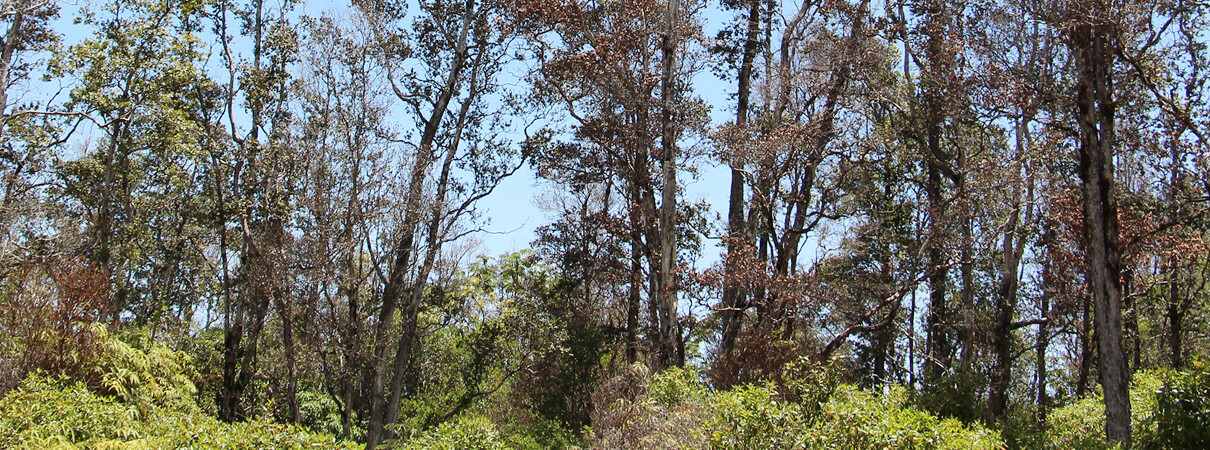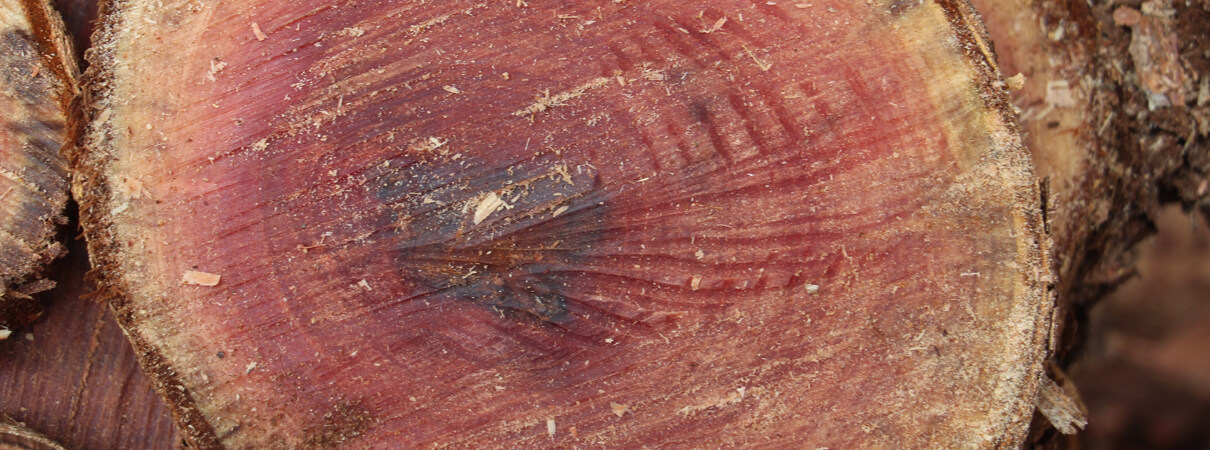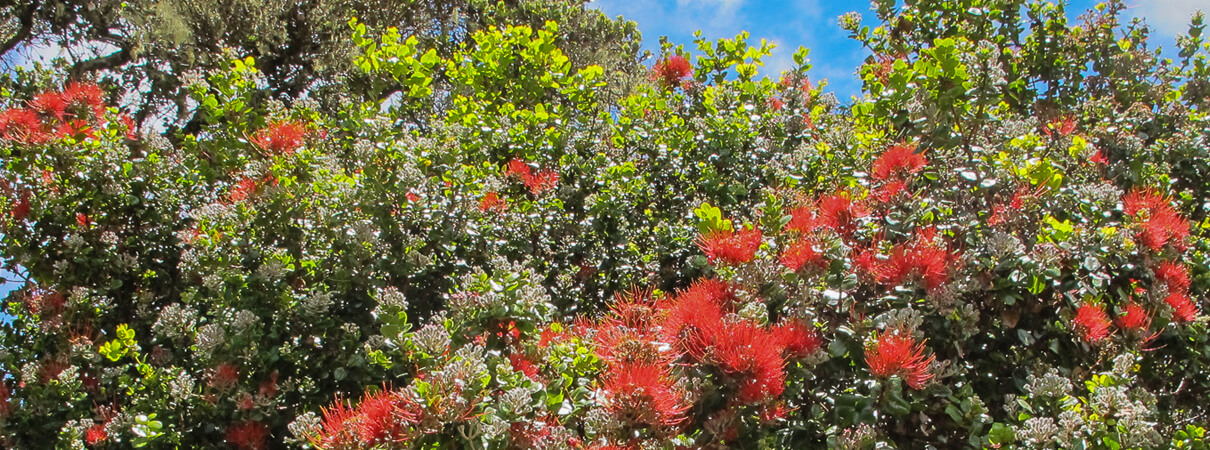Rapid 'Ohi'a Death Threatens Habitat for Hawai'i's Forest Birds
Hawai'i's native forest birds are in danger of losing a keystone tree species in most of their remaining habitat as a virulent disease wipes out tens of thousands of acres of mature 'ohi'a trees.
The disease, known as rapid 'ohi'a death, is caused by the fungus Ceratocystis fimbriata. Ceratocystis is known as a tree-killer around the world, and different species of the fungus have affected oaks, coffee, cacao, and several other species. But the strain currently attacking the 'ohi'a tree is considerably more aggressive than those that have previously invaded Hawai'i.

The Hawai'i 'Akepa is an endangered forest bird that depends on the 'ohi'a tree (shown) to survive. Photo by Jack Jeffrey
The current infestation has so far affected 34,000 acres on Hawai'i Island—also known as the Big Island—and has killed over 100,000 'ohi'a trees. Scientists suspect many more trees are infected but haven't yet died.
The 'ohi'a tree—also called the 'ohi'a lehua tree—has deep roots in Hawai'i's history and culture, and plays a key role in its ecosystems. The tree and its lehua flower are precious to the Hawaiian people; even plucking the flower from the tree is taboo in accordance with Hawaiian folklore. Many consider it to be the most important tree in the state.

On Hawai'i's Big Island, thousands of 'ohi'a trees like these are dying of rapid 'ohi'a death. Photo by J.B. Friday/University of Hawaii
Foundation of Hawaiian Forests
Birds and many other species depend upon the 'ohi'a tree to survive. It provides food and nesting sites for many of Hawai'i's forest birds, including federally endangered species such as the Hawai'i 'Akepa and Hawai'i Creeper. With the majority of Hawai'i's endemic birds at risk of extinction, losing the dominant tree from their remaining habitat makes these birds even more vulnerable, particularly if the fungus spreads to additional islands.
Even non-threatened birds, such as the 'I'iwi and the most common remaining native bird, 'Apapane, could become endangered following severe habitat loss.
Rapid 'ohi'a death presents a double threat to Hawai'i's native biodiversity. As this disease wipes out 'ohi'a trees, an integral part of Hawaiian ecosystems, non-native invasive weeds most often take their place, says Chris Farmer, ABC's Hawai'i Program Director.

Other Hawaiian birds such as the 'I'iwi may become endangered if their 'ohi'a habitat continues to disappear. Photo by Robby Kohley
“Hawai'i's birds have already suffered massive habitat loss, and most are now confined to small fragments of remaining native forest,” he says. “Since 'ohi'a makes up approximately 80 percent of our native forests, replacing that with invasive trees and shrubs would cause the loss of many birds, snails, arthropods, and other native plants found nowhere else in the world.”
A Stealth Killer
Scientists don't know how rapid 'ohi'a death got to Hawai'i, and it is far more lethal than other plant diseases in the history of the archipelago. Infected trees show no outward signs of being sick until two weeks before death, making the disease, to a certain extent, a stealth killer. It is currently impossible for scientists to determine how many trees are harboring the fungus.
The only way to diagnose an 'ohi'a tree infected with rapid 'ohi'a death is to cut open the trunk. Dark streaks staining the sapwood are revealed in the cross-section of an infected tree.

The wood of infected trees shows dark stains. Photo by J.B. Friday/University of Hawai'i
Although plants have a rudimentary immune response that defends against viral, bacterial, and fungal pathogens, this fungus is too aggressive for the trees to ward off. Entering through a wound in the trunk, the disease cuts off the tree's water supply by attacking the vascular system. Rather than protect against the fungus, the 'ohi'a tree's immune response further clogs its vascular system, accelerating its death.
Rushing to Contain
There appears to be no cure for rapid 'ohi'a death, says Lisa Keith, a research plant pathologist with the U.S. Department of Agriculture. The main objective now, she says, is to stop the spread of the disease before beginning to restore the ravaged forests.
Experts in Hawai'i are working with scientists around the world to understand and contain rapid 'ohi'a death before it spreads statewide. So far the disease is confined to the Big Island; one of the biggest threats is the fungus “jumping” to another island.
The Hawai'i Department of Agriculture has imposed a quarantine that prohibits movement of all 'ohi'a plants or plant parts, including flowers, leaves, seeds, stems, twigs, logs, and soil, among the Hawaiian Islands except by permit. Violation of the quarantine is a misdemeanor and carries fines of up to $10,000.

The 'ohi'a tree and its bright lehua flower are precious to the Hawaiian people; even plucking the flower from the tree is taboo in accordance with Hawaiian folklore. Photo by Chris Farmer/ABC
The agency is also advising landowners to cut down infected trees. This makes them less of a target for beetles that can spread the disease: Sawdust from boring beetles can contain the fungus spores and become airborne or get into the soil and water, making it a potential vector to spread rapid 'ohi'a death near and far.
Landowners are also advised to cover the felled trees with tarps until the fungus is no longer viable. Spores inside the tree can remain alive for at least a year after a tree dies, Keith says.
Organizations such as the Hawai'i Department of Land and Natural Resources, Hakalau Forest National Wildlife Refuge, and Hawai'i Volcanoes National Park are all working to educate the public on how to comply with these containment regulations and have instituted biosecurity measures for staff and researchers to prevent increased spread. There is an urgent need to further develop effective containment protocols, ensure they are understood, and followed by everyone.
Community Support for the 'Ohi'a Tree
Many Hawaiians understand the threat and need little persuasion to help in the containment effort. At the annual Merrie Monarch Festival, celebrated on the Big Island, tradition calls for lehua blossoms and new leaves from the 'ohi'a tree to adorn the costumes worn in hula competitions.
This year, scientists and community leaders cautioned against using 'ohi'a from the Big Island because of the outbreak. Many participants instead used leaves and flowers from other plants for the festival, showing their support for protecting the Hawaiian ecosystem.

The 'ohi'a tree provides nectar and nesting sites for many of Hawai'i's forest birds, including federally endangered species such as the Hawai'i Creeper. Photo by Jack Jeffrey
In addition to short-term containment strategies, there are also plans to rehabilitate the 'ohi'a forests. The University of Hawai'i's Lyon Arboretum has launched a seed-banking effort to preserve rare varieties of 'ohi'a. The seed conservation lab will collect and preserve seeds to be used for future forest restoration. Selection for plants that are resistant to rapid 'ohi'a death is another long-term strategy now in development.
“There is always hope,” Keith says. “Even in the most devastated areas, there are trees that have survived.”
Rapid 'ohi'a death is yet another challenge for Hawai'i's birds, along with non-native predators like cats, pigs, goats, and sheep; avian diseases; and the effects of climate change, ABC's Farmer says.
“But there are strategies and solutions for all these issues, and ABC is working hard with our partners across the state to address the threats facing Hawai'i's endemic birds,” he says. “We can save the remaining birds, and ABC is committed to making it happen.”
 Audrey Goldfarb is American Bird Conservancy's writing/communications intern. She is currently an undergraduate at the University of Rochester, where she is pursuing a bachelor's degree in molecular genetics, with minors in journalism and psychology. Audrey grew up in a home visited by many birds, including Wild Turkeys, Eastern Bluebirds, Rose-breasted Grosbeaks, Northern Flickers, and Great Blue Herons.
Audrey Goldfarb is American Bird Conservancy's writing/communications intern. She is currently an undergraduate at the University of Rochester, where she is pursuing a bachelor's degree in molecular genetics, with minors in journalism and psychology. Audrey grew up in a home visited by many birds, including Wild Turkeys, Eastern Bluebirds, Rose-breasted Grosbeaks, Northern Flickers, and Great Blue Herons.


















































